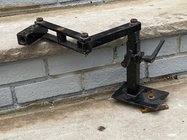-
It's time to cast your vote in the December 2025 Turning Challenge. (click here for details) -
Congratulations to Pat White for "Sicilian Mosaic" being selected as Turning of the Week for December 29, 2025 (click here for details) -
Welcome new registering member. Your username must be your real First and Last name (for example: John Doe). "Screen names" and "handles" are not allowed and your registration will be deleted if you don't use your real name. Also, do not use all caps nor all lower case.
You are using an out of date browser. It may not display this or other websites correctly.
You should upgrade or use an alternative browser.
You should upgrade or use an alternative browser.
Tool manufacturer anybody
- Thread starter Dennis Weiner
- Start date
Looks like my home-made setup, adapted from Eddy Castelin's hollowing snake. I suspect it's a one-off.
john lucas
AAW Forum Expert
Possibly homemade.
Thanks, Kevin and John. I appreciate your replies.
I might add, I generally prefer the least amount of connections or joints in any of my woodturning tools in order to reduce the risk of vibration. I prefer a single bar over one that has been joined multiple times such as this articulated hollower. However, this particular hollower is one that I may wish to own. The joints are extremely tight and solid. No slop whatsoever. So, who made it, is the question.
I might add, I generally prefer the least amount of connections or joints in any of my woodturning tools in order to reduce the risk of vibration. I prefer a single bar over one that has been joined multiple times such as this articulated hollower. However, this particular hollower is one that I may wish to own. The joints are extremely tight and solid. No slop whatsoever. So, who made it, is the question.
john lucas
AAW Forum Expert
I know there was one like that produced because I was thinking about building a home version. I just never got around to it
I believe it was a copy of the Monster Articulated System.
You'll greatly appreciate all the articulation joints when doing a flatter hollow form and you have a nearly perpendicular to the bed cut. I much prefer the articulated hollowersI might add, I generally prefer the least amount of connections or joints in any of my woodturning tools in order to reduce the risk of vibration. I prefer a single bar over one that has been joined multiple times such as this articulated hollower. However, this particular hollower is one that I may wish to own. The joints are extremely tight and solid. No slop whatsoever. So, who made it, is the question.
looks like a version of this unit. Home built?
However I do not see any size or scale to your photo so can not judge.
Stu
However I do not see any size or scale to your photo so can not judge.
Stu
My guess is also that it is homemade or an older, low volume, product that's no longer manufactured -- the 3 set screws on the receiver, and two screws on the height adjuster are unusual features. With some cleanup it will be a valuable tool.
I don't know how big the receiver is, but Trent Bosch sells a nice set of adapter sleeves.
Not saying you couldn't try a long bar, but the design probably works best with shorter tools.
When you mount a tool, you set it up with mild to modest down pressure on the tool rest, so vibration from the joints is not an issue. And tool movement secure and steady. (I can let go of the tool a few mm from the wood and expect it to stay put).I generally prefer the least amount of connections or joints in any of my woodturning tools in order to reduce the risk of vibration.
I don't know how big the receiver is, but Trent Bosch sells a nice set of adapter sleeves.
Not saying you couldn't try a long bar, but the design probably works best with shorter tools.
Thanks all for your help. I noticed my friend placed it on Craig’s list (Northvale NJ) if anyone is interested..
I believe the originals were "elbow tools" which were mounted in tailstock....this one mounted on the ways, hollowing tool ur choice....John Jordan, Trent Bosch, hunter tools, etc,etc used with it....this is incomplete ....compre prices to what's available.....older incomplete systems should be bargain prices

